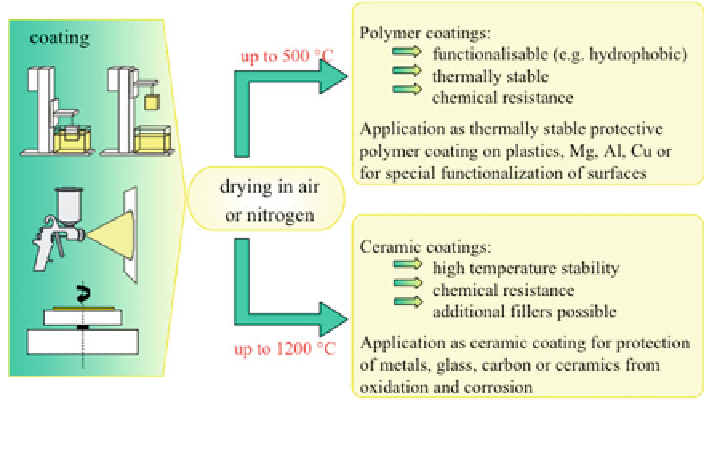Environmental Engineering Reference
In-Depth Information
Fig. 7 Typical coating techniques involving preceramic polymers, as well as classification and
applications of the resulting coatings
The precursor technique thus exhibits a relatively low cost and easy approach to
produce polymeric and ceramic coatings. The coatings are mainly obtained from
silicon-based precursors such as polysiloxanes (Torrey and Bordia
2008b
), or
polysilazanes (G
nthner et al.
2009a
). In order to use preceramic polymers for
coating processes, either liquid state or solubility in organic solvents is necessary.
A tailorable rheology is a precondition for applying the suitable coating technology
to get the optimal coating performance.
ü
2.2.1 Polymer Coatings Based on Polysilazanes (T < 500
°
C)
In contrast to the limited thermal stability of coating systems based on organic
polymers, preceramic polymers have a higher temperature stability after they have
been cross-linked. In the case of the moisture-sensitive silazanes, this reactivity
leads to an additional cross-linking and is very advantageous for the adhesion of the
coating with the oxidic surface of the substrate due to reaction of functional groups
of the silazane precursor with
OH groups of, e.g., metals. Figure
8
shows a copper
sheet dip-coated with a silazane in the lower region and heat treated in air at 500
−
°
C.
Though the coating thickness is only 1
µ
m, the coating protects copper from
oxidation up to 500
C. In contrast, the uncoated region shows the typical oxidation
of copper into black copper oxides (G
°
nthner et al.
2007
).
Polysilazane can contain various functional reactive groups not only suitable for
cross-linking reactions. Functionalities of Si
ü
H, Si-vinyl, or N
H groups are pre-
-
-
destinated for further modi
cations due to their reactivity. Reactions with molecules
containing very polar groups such as carboxylates can lead to the modi
cation of

Search WWH ::

Custom Search